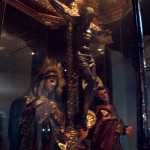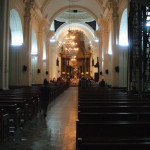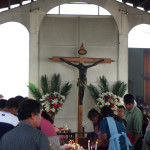Face to Face with El Cristo Negro
- The 1595 original now stands behind glass
- Interior of the Basilica of Esquipulas
- A replica of El Cristo Negro is located outside
The most important day at the Basilica of Esquipulas is January 15, when many thousands of pilgrims flock from all over Latin America.
Ask most Guatemaltecos what is in Chiquimula and you will invariably receive the reply: “El Cristo Negro,” often followed by, “That is all there is in Chiquimula …” Undaunted by such disparaging remarks and the prospect of a long journey, I set out from Guatemala City on a trip that would end in the Basilica of Esquipulas, face to face with El Cristo Negro (the Black Christ).
The city of Esquipulas is a five-hour drive from the capital in the department of Chiquimula, which is in eastern Guatemala, close to the borders with Honduras and El Salvador. The Catholic faith arrived in the region in 1525, brought by the Conquistadors, and, after intense resistance waged by the indigenous inhabitants, a peace treaty was signed in 1530. After this reconciliation, a church was founded in honor of Santiago, the patron saint of Spain, and it was here that the rise of El Cristo Negro was initiated in 1595.
The sculpture was commissioned the previous year by Bishop Morales, from a Portuguese artist, Quirio Catano, a long-term resident of the area, who was familiar with its particular history.
Two competing versions account for the color of El Cristo Negro. The first explanation suggests that it was the result of an administrative oversight, and that the required color and characteristics of the figure of Christ were not specified to Catano. Catano delivered the finished sculpture in the naturally dark color of the wood it was made from and it was accepted. Another version credits Catano as being a man of grand philosophical vision, who clearly conceived of the black Christ as a work of national importance, a uniquely Guatemalan symbol, that would fuse the suffering inflicted on the native population with that endured by Christ. On a more practical level, he also thought his creation likely to prove a sensation with pilgrims, a presentiment borne out in the five centuries since.
Made from lemon wood and darkened further with the fumes from incense, the Cristo Negro was installed in March 1595. For the next century and a half, it resided in the church of Santiago until, in 1759, it was transported a kilometer or so to the newly built Church of Esquipulas, where it stands today. Upgraded to the status of basilica in 1961, the imposing church was financed by a group of men from La Antigua. Maintained in pristine white with a wonderful brown-orange dome, the Basilica of Esquipulas stands in its own gardens, where visitors relax shaded by enormous palm trees.
Throughout the centuries, numerous miracles have been attributed to El Cristo Negro, and large displays inside the church document these personal stories. In recognition of divine assistance, pilgrims have presented small plaques, expressing gratitude or simply small silver images of the particular body parts healed by El Cristo Negro, and these can be viewed on the approach to the statue itself. While for many centuries, visitors were at liberty to approach and kiss the statue, and did so, fervently, wear and tear (and perhaps common sense) have since dictated that El Cristo Negro retire behind a glass screen; he is now watched over by a security camera.
As I stood there, waiting my turn, pigeons flew in from a hole in the dome, swirling in circles and swooping into the midst of an ongoing service. Nobody paid any notice. The man in front took care as he photographed the statue with his cellphone, and then, after a few silent moments before the figure, he retreated, walking backward away from El Cristo Negro, a traditional Catholic show of respect when visiting such icons.
Walking around the outside of the church, visitors may be surprised to discover a second El Cristo Negro, in a covered area where thousands of candles burn, these offerings tended diligently by a priest. This El Cristo Negro is a recently commissioned replica, a practical measure that permitted the candles to be relocated outside, as over the years they had caused significant damage to the floor of the basilica.
The most important day at the Basilica is the 15th of January, when many thousands of pilgrims flock to Esquipulas from all over Latin America, in scenes reminiscent of Semana Santa in La Antigua. The people come both to request assistance from El Cristo Negro and to fulfill promises to return, made in exchange for assistance that was gratefully received. In years past, it was common for cars and buses to park inside the gardens in the days preceding the 15th, stretching out sheets of tarpaulin and creating an impromptu settlement. Today, a perimeter fence thwarts vehicles, but it is still common for pilgrims to camp in the grounds, to secure a prime spot on the big day. Another practice that is observed is that many visitors, in a display of humility, approach the basilica on hands and knees, crawling the few hundred meters or so, from the entrance to the park, up the steps, and to the church itself, before joining the long lines waiting for their turn with El Cristo Negro.
Having made the journey myself, without knowing what I would find, I was delighted to discover such a magnificent building and so many rich details of the experiences that have occurred there. One cannot help but be impressed by the atmossphere that centuries of reverence and awe have created around the figure of El Cristo Negro, and with the thought of the many thousands who have passed here before, each with their own unique story. While there may be a grain of truth in the notion that all Chiquimula offers visitors by way of attractions is the Cristo Negro at the Basilica of Esquipulas, the church stands as a singular statement of religious faith in Guatemala and a visit there can be at once a pleasure and an inspiration.



A very informative article. Contrary to many I have read from foreigners and non-Catholics, this is very respetful and does not go into ridiculing traditional costums.
I have visited Esquipulas since before paved roads and I am very familiar with traditions regarding the pilgrimage to Esquipulas.
I enjoyed reading it an look forward to others like this.
I would be a little concerned that the people from Chiquimula would resent the comment that there is nothing else in Chiquimula, whomever said that should visit the Departmente and for starters, should climb Ipala Volcano to the lake in the crater.
Great article!